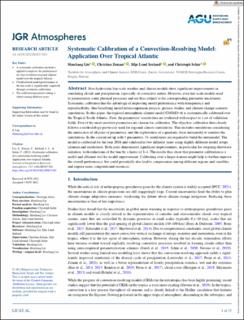| dc.contributor.author | Liu, Shuchang | |
| dc.contributor.author | Zeman, Christian | |
| dc.contributor.author | Sørland, Silje Lund | |
| dc.contributor.author | Schär, Christoph | |
| dc.date.accessioned | 2023-01-13T14:15:26Z | |
| dc.date.available | 2023-01-13T14:15:26Z | |
| dc.date.created | 2023-01-10T12:57:40Z | |
| dc.date.issued | 2022 | |
| dc.identifier.citation | Journal of Geophysical Research (JGR): Atmospheres. 2022, 127 (23), . | en_US |
| dc.identifier.issn | 2169-897X | |
| dc.identifier.uri | https://hdl.handle.net/11250/3043444 | |
| dc.description.abstract | Non-hydrostatic km-scale weather and climate models show significant improvements in simulating clouds and precipitation, especially of convective nature. However, even km-scale models need to parameterize some physical processes and are thus subject to the corresponding parameter uncertainty. Systematic calibration has the advantage of improving model performance with transparency and reproducibility, thus benefiting model intercomparison projects, process studies, and climate-change scenario simulations. In this paper, the regional atmospheric climate model COSMO v6 is systematically calibrated over the Tropical South Atlantic. First, the parameters' sensitivities are evaluated with respect to a set of validation fields. Five of the most sensitive parameters are chosen for calibration. The objective calibration then closely follows a methodology previously used for regional climate simulations. This includes simulations considering the interaction of all pairs of parameters, and the exploitation of a quadratic-form metamodel to emulate the simulations. In the current set-up with 5 parameters, 51 simulations are required to build the metamodel. The model is calibrated for the year 2016 and validated in two different years using slightly different model setups (domain and resolution). Both years demonstrate significant improvements, in particular for outgoing shortwave radiation, with reductions of the bias by a factor of 3–4. The results thus show that parameter calibration is a useful and efficient tool for model improvement. Calibrating over a larger domain might help to further improve the overall performance, but could potentially also lead to compromises among different regions and variables, and require more computational resources. | en_US |
| dc.language.iso | eng | en_US |
| dc.rights | Navngivelse 4.0 Internasjonal | * |
| dc.rights.uri | http://creativecommons.org/licenses/by/4.0/deed.no | * |
| dc.title | Systematic Calibration of a Convection-Resolving Model: Application Over Tropical Atlantic | en_US |
| dc.title.alternative | Systematic Calibration of a Convection-Resolving Model: Application Over Tropical Atlantic | en_US |
| dc.type | Peer reviewed | en_US |
| dc.type | Journal article | en_US |
| dc.rights.holder | © 2022 Eidgenossische Technische Hochschule Zurich and The Authors | en_US |
| dc.description.version | publishedVersion | en_US |
| cristin.ispublished | true | |
| cristin.fulltext | original | |
| cristin.qualitycode | 2 | |
| dc.identifier.doi | 10.1029/2022JD037303 | |
| dc.identifier.cristin | 2104088 | |
| dc.source.journal | Journal of Geophysical Research (JGR): Atmospheres | en_US |
| dc.source.volume | 127 | en_US |
| dc.source.issue | 23 | en_US |
| dc.source.pagenumber | 0 | en_US |

